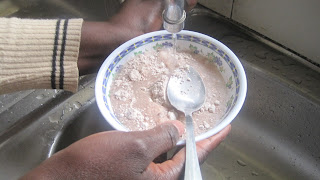I’ve had a lot of confusing moments in Kenya. Like the first weekend, when I took a matatu (a mini-van) from Busia to Kakamega and was brusquely pulled off in Mumias next to a sign advertising “Kakamega Forest – 63 km” (Luckily, I was just transferring to another matatu that took me to Kakamega, but a very terrified me with mental images from a few too many episodes of Criminal Minds almost took out the confused matatu conductor before he could give me an explanation). Or, when we showed up to a meeting almost 2 hours after the start time, only to find that the meeting hadn’t even begun yet. Africa time is alive and well in Kenya.
But the one thing that confuses me the most is the fact that so many AIDS orphans exist within Kenya. I’m not sure if it is due to western influence redefining and consolidating the concept of family, abject poverty preventing familial responsibilities, or greedy relatives who take the land and leave the child, but there are a lot of orphans out there. Street kids who beg for money (or steal it from a Mzungu who doesn’t have the good sense to transfer her backpack to the front when swarmed with a crowd of the street kids) with glue bottles held in their mouth for a constant high are disconcertingly common, although females are strangely absent as street children. In the more rural areas, there are usually one or two boys, but in large cities, their large numbers become absolutely astonishing. And it seems like a quarter of the adults I’ve met either run or have some kind of connection to an orphanage. When I see how accommodating and close-knit the community is here, I feel like I’m missing something about the stunning amount of children left on their own. My host sister says that many street kids run away because they don’t want to go to school, but I find it hard to comprehend that there are that many kids (often as young as 7 or 8) who hate school that much that they are willing to trade a roof over their head and regular meals for the “freedom” of getting drenched in the daily afternoon showers and digging through trash. Where are their extended families in this whole equation?
Ah, sorry to be so depressing. On to happier thoughts on families.
The family structure here is the strongest that I have ever seen. For example, cousins are referred to as brothers and sisters (which perhaps explains why the stated size of my host family ranges anywhere from 5 to 15 depending on who you ask and when), and people frequently take off entire months just to hang out with the fam. Every major event in life is an event for the entire extended family, from births to dowry negotiations to funerals, and many homes have at least 1 or 2 unoccupied beds for when some mother-in-law’s cousin’s brother invariably arrives. Or, you know, their host daughter’s mom and sister, as happened these past two days. My host family has always been beyond amazing and welcoming, and this was certainly no exception. They took such great care of my family, and my host sister even gave up her room for my family (She moved to one of the aforementioned empty beds for visitors). Last night, we cooked a great family dinner together, with lots of help from Mamma Mary. Mamma Vern was surprisingly good at stirring ugali from practice stirring mashed potatoes, while Kaitlin and I prepared one of her favorite Kenyan dishes, Kachumbari, which is today’s recipe.
Kachumbari is essentially a vegetable salad (Ok, a veggie salad with tomatoes if we’re aiming for biological accuracy) that is likely to be a staple in the apartment next semester. Partially because it’s equal parts tasty and simple, partially because you can make a big batch and nosh for a few days, partially because I suspect my roommate loves onions more than she loves me (which is honestly pretty understandable), and partially because you can slice up something that is a day or two past the eatable stage, and it will still taste amazing.
Typically, Kachumbari is a mix of chopped tomatoes and onions with lemon, but we added quite a few extras last night, so be creative!
Kachumbari (serves 5)
Prep time: 15 minutes, depending on your chopping skills and number of vegetables
Supplies: A very sharp knife, 2 bowls, cutting board
Essential ingredients: 4-6 tomatoes, 2 onions, ½ tbsp. salt, 2 tbsp. apple cider vinegar (clear vinegar), 2-3 sprigs cilantro
Recommended Ingredients: ½ lemon, 2-3 carrots, 1 bell pepper, 1 cucumber, whatever else is in your fridge!
1) Wash all vegetables. Dice the tomatoes, onions, and whatever else is going in, but keep the onions separate.
4) Add the washed cilantro leaves and cover with vinegar and/or lemon (either will do, honestly, but I prefer the vinegar). Both lemon and vinegar also help take the bite from raw onions. Stir and enjoy!























